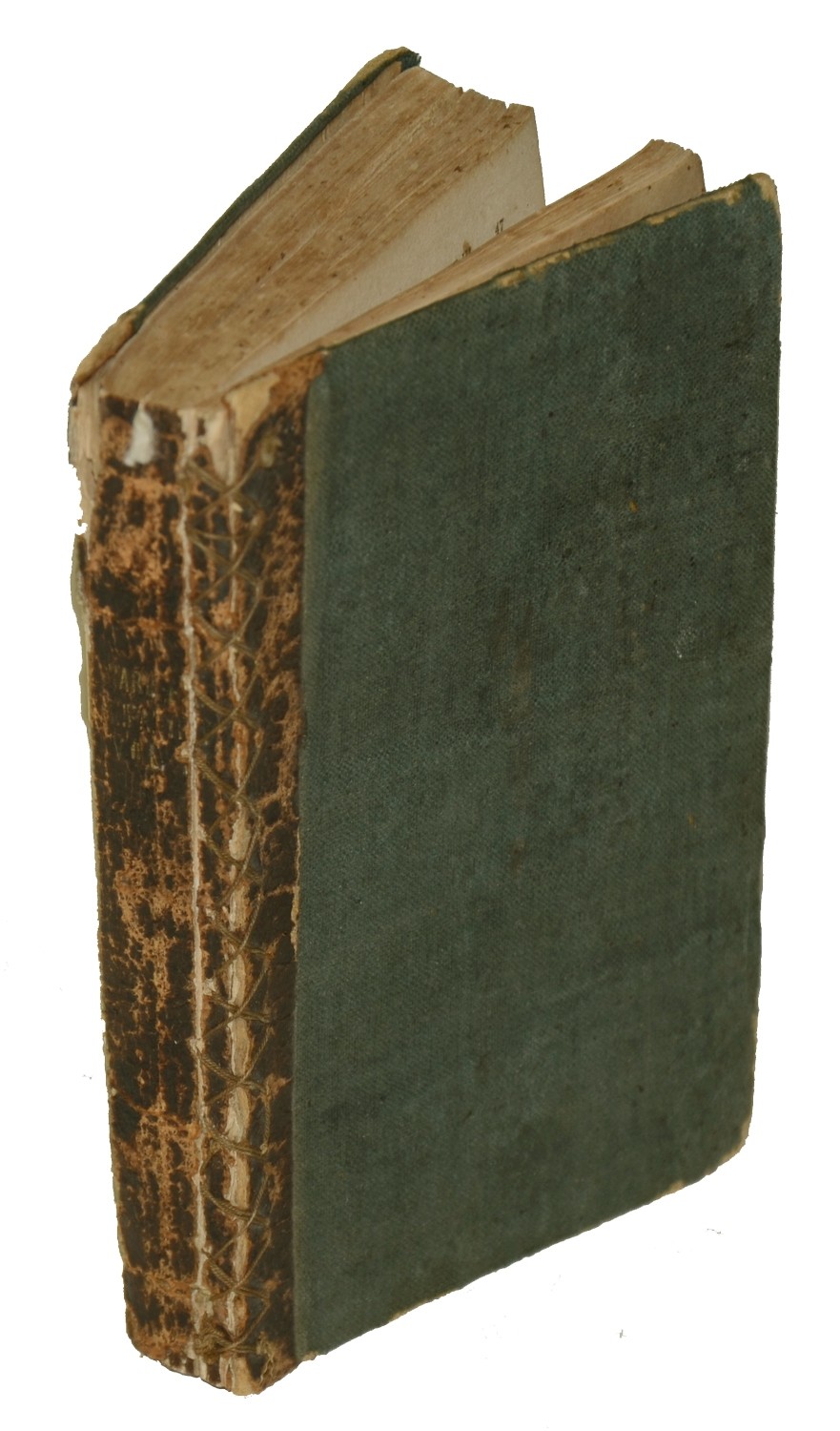site search
online catalog
CONFEDERATE TACTICS MANUAL PICKED UP BY 72ND OHIO OFFICER AT SHILOH

Hover to zoom







$550.00 SOLD
Quantity Available: None
Item Code: 846-184
Manual is a Confederate imprint of Hardees Tactics. Title page reads “RIFLE AND INFANTRY TACTICS REVISED AND IMPROVED BY BRIG. GEN. W. J. HARDEE, C.S.A. VOLUME II THE SCHOOL OF THE BATTALION.” The bottom of the title page states that the manual was printed by “S. H. GOETZEL & CO. MOBILE / FIRST YEAR OF THE CONFEDERACY.”
The volume meas. approx. 3.50 x 5.25 inches and runs 232 pages. The covers are of green cloth with a leather covered spine. The leather on the spine is worn and very tired. Covers show light wear from rubbing on edges and the front cover has been sewn in place. This was done long ago. The binding is good. Most of the plates are present but some of the fold out plates are missing small sections.
Inside front cover has the remains of a paper label that appears to have been an advertisement. Written in period pencil on the top of the first blank page is “LIEUT. M. REES.” Below it in ink is “MORRIS REES / PEMBERVILLE / OHIO” and below this is “FROM SHILO.”
First few page edges are dog-eared slightly while the rest of the page edges show age and surface dirt.
Morris Rees was 23 years old when he enlisted as a Private in Company D, 72nd Ohio on October 26, 1861. He rose to be 1st Sergeant and was commissioned a 2nd Lieutenant on September 3, 1862 and 1st Lieutenant on April 9, 1864. He was captured at Ripley, Mississippi on June 11, 1864 and confined at Macon, Georgia and Columbia, South Carolina. He was mustered out on April 24, 1865.
While Rees was with the 72nd it saw action at Shiloh, Corinth, Vicksburg and Brice’s Cross Roads.
Ohiosyesterdays.blogspot has the following information about Lieutenant Rees:
“Through the recollections of Civil War soldiers, we learn that they, like others who have served in combat, struggled with the haunting memories of their experience. One of those was Captain Morris Rees, the last surviving commissioned officer of the 72nd Ohio Volunteer Infantry.
Before the war, Rees lived near Rollersville, Ohio, surrounded by a large number of his Welsh relatives. He remembered that at the age of 23, he “had the war fever so bad” that he left his wife and child “and went to Woodville alone in the night for the purpose of enlisting.” So filled with patriotism was Rees, that he recruited his friends, neighbors, and relatives to join him in fighting for the Union cause.
But the Civil War was not the glorious adventure Captain Rees had envisioned. He endured some of the conflict’s most horrific battles, disease, wounds, and months of imprisonment. Rees survived, but many of those he had recruited did not. After the war, Captain Rees wrote that he had “often looked at that long list of names and thought how soon they were all used up, nearly all gone in less than a year.”
Among the many Rees recruited was his uncle Evan, who died shortly after enlisting. He left behind a widow and three sons in a fragile economic state. Perhaps most painful for Rees was the death of his younger brother John. Immediately after Captain Rees’ release from prison, he went directly to Andersonville where his brother had languished near death for more than nine months. With the war nearly at an end, Captain Rees gained his brother’s freedom by threatening the Rebel guard with his life. But John was so weak that he died before reaching home.
When the veterans of the 72nd gathered for reunions, they rarely recounted their victories and their heroic war deeds. Instead, Captain Rees and others became pre-occupied with compiling and publishing the names, death dates, and burial places of their lost comrades. As survivors, it was their way of honoring the suffering and sacrifice of their lost comrades.
Sharing their memories of death and loss was not enough. Rees and 16 Sandusky County veterans returned to the South in 1887. Rees recorded the condition of the cemeteries and the exact number of graves in each. Perhaps in some way, seeing the old battlefields and cemeteries brought a measure of healing to the captain. However, he remained deeply disturbed by the “thousands of unidentified dead.”
In time, Captain Rees and other veterans worked to erect monuments at home and on the battlefields of Shiloh, Antietam, Chickamauga, and Vicksburg. In this 150th year of commemoration, the monuments serve as vivid reminders of the suffering and sacrifice of so many who gave their “last full measure” in the defining moment of our nation’s history.”
Great Shiloh relic and Confederate imprint. [ad]
~~~~~~~~~~~~~~~~~~~~~~~~~~~~~~~~~~~
THIS ITEM, AS WITH ALL OTHER ITEMS AVAILABLE ON OUR WEB SITE,
MAY BE PURCHASED THROUGH OUR LAYAWAY PROGRAM.
FOR OUR POLICIES AND TERMS,
CLICK ON ‘CONTACT US’ AT THE TOP OF ANY PAGE ON THE SITE,
THEN ON ‘LAYAWAY POLICY’.
Inquire About CONFEDERATE TACTICS MANUAL PICKED UP BY 72ND OHIO OFFICER AT SHILOH
Most Popular
Historical Firearms Stolen From The National Civil War Museum In Harrisburg, Pa »
Theft From Gravesite Of Gen. John Reynolds »
Selection Of Unframed Prints By Don Troiani »
Fine Condition Brass Infantry Bugle Insignia »
Large English Bowie Knife With Sheath 1870’S – 1880’S »
Imported (Clauberg) Us Model 1860 Light Cavalry Officer's Saber »
featured item
EXTRAORDINARILY RARE AND IMPORTANT CONFEDERATE RAINS BARREL TORPEDO - 1 OF 2 KNOWN - FROM THE TEXAS MUSEUM
This is a Rains barrel torpedo that was recovered during the Civil War in Mobile Bay, AL. It was developed by Gabriel James Rains, Chief of the Confederate Torpedo Service. Gabriel Rains was born in Craven County, NC and entered West Point,… (1268-690). Learn More »


